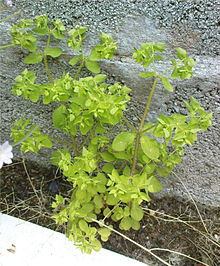Map Snapshot


1 Record
Seasonality Snapshot
Source: Wikipedia
| Euphorbia peplus | |
|---|---|

| |
| Scientific classification | |
| Kingdom: | Plantae |
| Clade: | Tracheophytes |
| Clade: | Angiosperms |
| Clade: | Eudicots |
| Clade: | Rosids |
| Order: | Malpighiales |
| Family: | Euphorbiaceae |
| Genus: | Euphorbia |
| Species: | E. peplus
|
| Binomial name | |
| Euphorbia peplus | |
Euphorbia peplus (petty spurge,[1][2] radium weed,[2] cancer weed,[2] or milkweed),[2] is a species of Euphorbia, native to most of Europe, northern Africa and western Asia, where it typically grows in cultivated arable land, gardens and other disturbed land.[1][3][4]
Outside of its native range it is very widely naturalised and often invasive, including in Australia, New Zealand, North America and other countries in temperate and sub-tropical regions.[1]
Description
[edit]It is an annual plant growing to 5–30 cm (2–12 in) tall (most plants growing as weeds of cultivation tend towards the smaller end), with smooth hairless stems. The leaves are stalked, oval-acute, 1–3 cm (0.4–1.2 in) long, with untoothed margin. It has green flowers in three-rayed umbels. The glands typically of Euphorbia are kidney-shaped, and have long thin horns.[4]
var. minima has stems low, ascending, branchy, leaves roundish, seeds smaller 1-1.4 mm (vs. 1.3-1.6 mm of var. peplus),[5] predominantly countries on the north edge of the Mediterranean (PoWo Map)

Medicinal uses
[edit]The plant's sap is toxic to rapidly replicating human tissue, and has long been used as a traditional remedy for common skin lesions.[6] The active ingredient in the sap is a diterpene ester called ingenol mebutate.
A pharmaceutical-grade ingenol mebutate gel has approval from the US Food and Drug Administration for treatment of actinic keratosis.[6][7][8]
In Germany, recent studies have linked Euphorbia peplus with the virtual elimination of squamous cell skin cancer.[9]
References
[edit]- ^ a b c "Euphorbia peplus". Germplasm Resources Information Network. Agricultural Research Service, United States Department of Agriculture. Retrieved 2 January 2018.
- ^ a b c d Hazel Dempster; Bronwen Keighery; Greg Keighery; Rod Randall; Bob Dixon; Bill Betts; Margo O'Byrne; Diane Matthews. "Euphorbia terracina Workshop Proceedings 2000" (PDF). Archived from the original (PDF) on 2009-10-25.
- ^ Flora Europaea: Euphorbia peplus
- ^ a b Blamey, M. & Grey-Wilson, C. (1989). Flora of Britain and Northern Europe. ISBN 0-340-40170-2
- ^ Davis. Flora of Turkey and the East Aegean Islands, vol. 7.
- ^ a b Siller G, Gebauer K, Welburn P, Katsamas J, Ogbourne SM (2009). "PEP005 (ingenol mebutate) gel, a novel agent for the treatment of actinic keratosis: results of a randomized, double-blind, vehicle-controlled, multicentre, phase IIa study". Australasian Journal of Dermatology. 50 (1): 16–22. doi:10.1111/j.1440-0960.2008.00497.x. PMID 19178487. S2CID 19308099.
- ^ Lebwohl, M, et al. "Ingenol Mebutate Gel for Actinic Keratosis." N Engl J Med 366;11, March 15, 2012.
- ^ "FDA Approves Picato® (ingenol mebutate) Gel, the First and Only Topical Actinic Keratosis (AK) Therapy With 2 or 3 Consecutive Days of Once-Daily Dosing". eMedicine. Yahoo! Finance. January 25, 2012. Archived from the original on February 10, 2012.
- ^ Braun, S.A.; Homey, B.; Gerber, P.A. (October 2014). "Erfolgreiche Behandlung eines Morbus Bowen mit Ingenolmebutat". Der Hautarzt (in German). 65 (10): 848–850. doi:10.1007/s00105-014-3509-5. ISSN 0017-8470. PMID 25217087.
External links
[edit]- Euphorbia peplus in the CalPhotos photo database, University of California, Berkeley



